Chapters in Development
Graphic Notation and Scores
Zach Gist and Chelsey Hamm
Key Takeaways
- Graphic notation contains virtually no rules. It is common to see abstract shapes, lines, images, patterns, colors, or even words in graphic scores.
- Augenmusik uses traditional staff notation, but alters musical features to display an image or design that provides additional symbolic meaning for its performers. Sometimes these scores create an ideogram, a picture or symbol which represent an idea or concept.
- Indeterminate music leaves elements within a composition up to the performer, or up to chance. Chance refers to the incorporation of random elements into a composition, which are often included by means of procedures such as coin flips, dice rolls, etc.
- Aesthetic relativism is a philosophical view which argues that the judgement of beauty is relative to an individual or culture (that there is no universal criteria for beauty).
- Scores that use a mixture of graphic and Western musical notations are sometimes called hybrid scores.
- Composers sometimes provide instructions or guidelines for their graphic scores. These instructions can be more or less detailed and might result in a more or less determinate performance. When interpreting scores with instructions, you should follow the directions or guidelines to the best of your ability.
- Sometimes graphic scores utilize timeline notation, in which time is measured with seconds rather than with bar lines and time signatures.
- A composer may also provide no indication of time progression within their score. When this is the case, we say the music is in free time.
Example 1 shows a graphic score:[1]
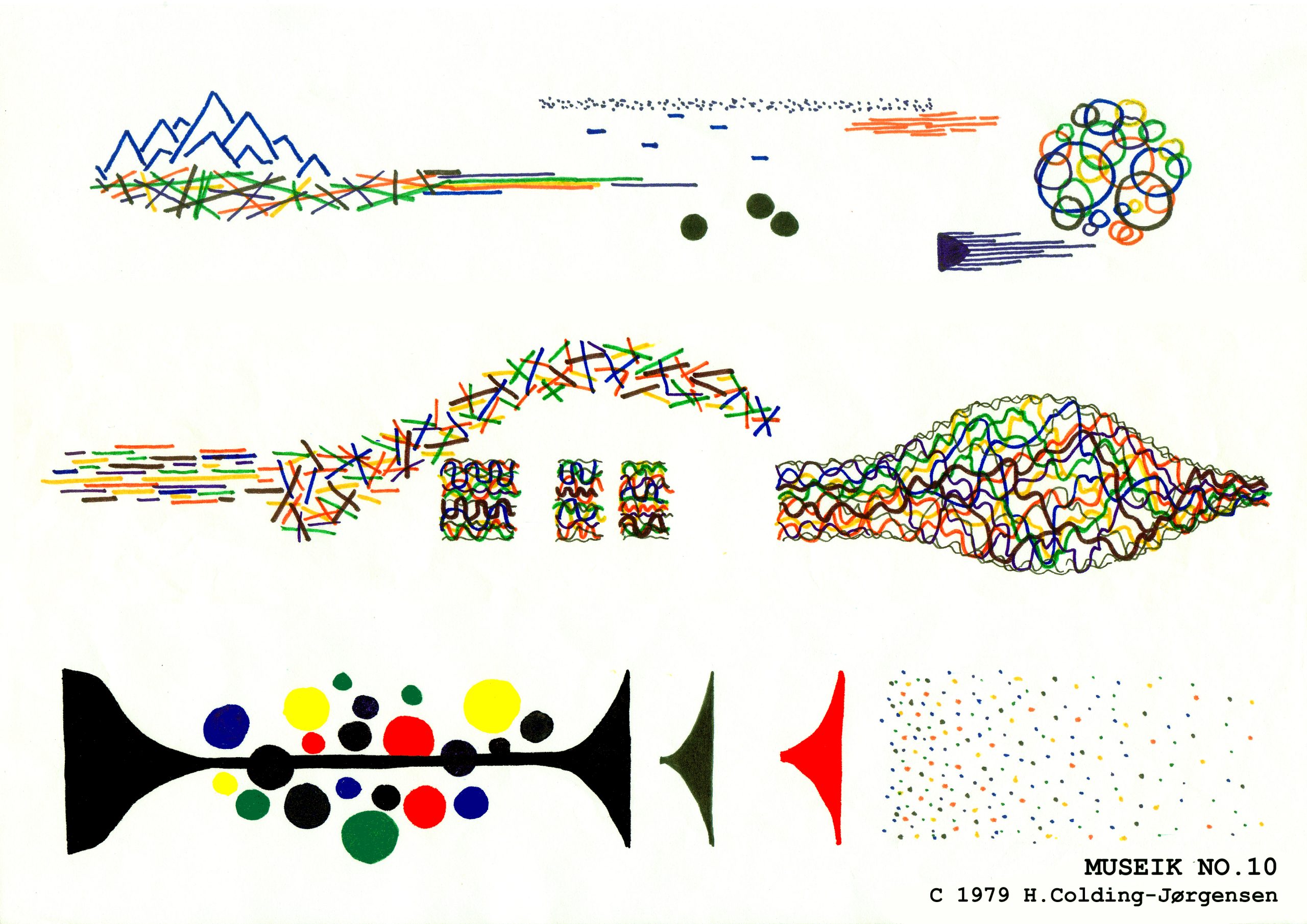
Although it may not look like it, Example 1 does indeed convey music. As you can see, it does not contain any of the features of traditional Western music notation that we have seen in previous chapters, such as a staff, notes, rests, etc. However, both systems of notation are equally as legitimate and effective when conveying information about a composition to a performer. As composer Malcolm Goldstein (b. 1936) has said, “Graphic notation is not a…pleasantry…it is a necessity to pass on the ideas [to] other performers and to understand what can be done.”[2] Unlike traditional staff notation that contains many rules about a score’s construction, graphic notation contains virtually no rules. It is common to see abstract shapes, lines, images, patterns, colors, or even words in graphic scores–there are no limitations that graphic scores must follow.
Thus, this type of notation is much less straightforward to understand. Comprehension within this chapter will rely upon concepts such as aesthetic relativism and indeterminacy, which we will further explore soon. But first we will need to discuss how and when composers started to utilize graphic notation.
A Brief History of Graphic Notation
Although the use of graphic notation arose in the twentieth century, compositions which included graphic elements can be found as early as the Renaissance. An example of one of these early non-traditional visual elements is called Augenmusik in German, which translates to “eye music.” Augenmusik generally uses traditional staff notation, but alters musical features to display an image or design that provides additional symbolic meaning for its performers.[3]
In some cases, composers would change the shape of their staves to create an ideogram. Such Augenmusik could be considered a graphic score. However, it should be noted that its visual symbolism does not actually change the sound or performance of the work; instead, it is solely an aspect of the work’s notation.
Example 2 shows one of the earliest and most famous uses of Augenmusik which is also an ideogram, the rondeau “Belle, Bonne, Sage,” (“Lovely, Good, Wise,”) by Baude Cordier, a 15th-century French composer. This love song is presented to its performers in the shape of a heart, further conveying a romantic theme.
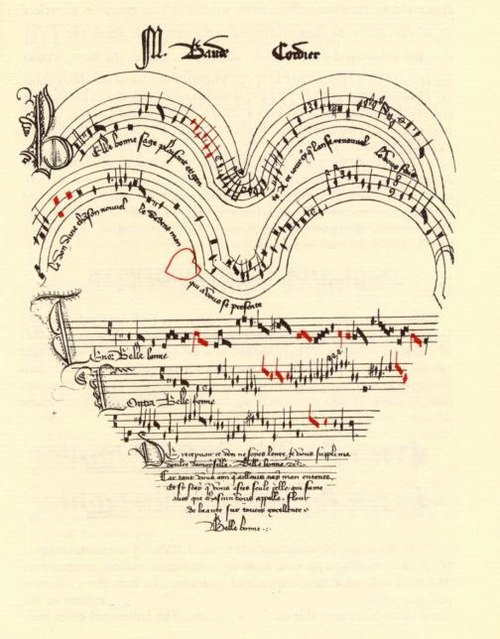
You can listen to a performance and follow along with the score to “Belle, Bonne, Sage” in Example 3. The notation in this video has been transcribed into modern staff notation, making it easier to follow.
Example 3. Animated performance of “Belle, Bonne, Sage,” created by Dr. Jordan Alexander Key.
A second, more recent example of Augenmusik is by composer John Dante Prevedini (b. 1987). Prevedini released his composition “Selfie” (seen in Example 4) in 2020,[4] the year in which the COVID-19 pandemic struck. During this time, he noticed that people became more active on social media because everyone was forced to stay indoors. He realized that “social media is a place for seeing, not hearing,” and challenged himself to find a way to make his music more visually appealing to online audiences.[5] “Selfie,” which depicts a self-portrait of the composer, is one result.
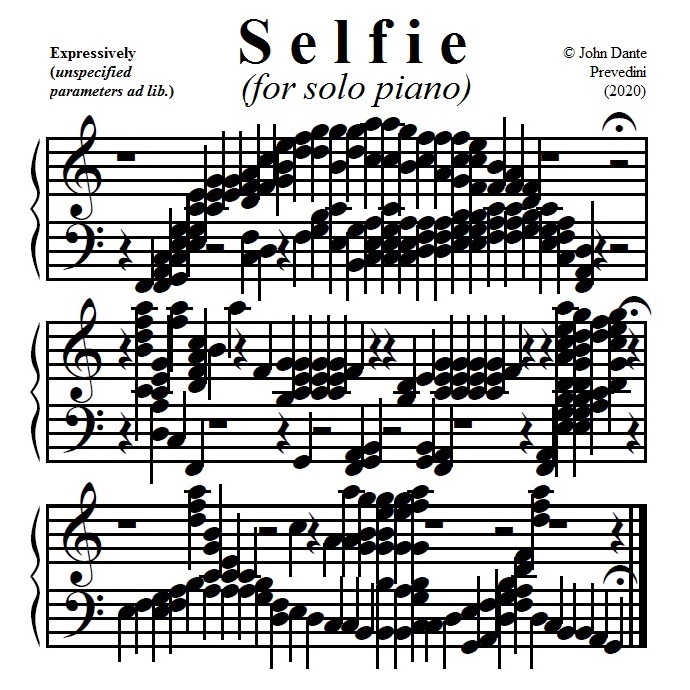
You may have noticed that this score is ametric, which is discussed further in Twentieth-Century Rhythmic Techniques. You can hear a performance of “Selfie” in Example 5:
Example 5. A performance of John Dante Prevedini’s “Selfie,” given by the composer.
In the early twentieth century, several composers were writing increasingly complex music which couldn’t necessarily be conveyed with traditional Western notation. For example, “Gustav Mahler’s music is littered with substantial amounts of written directions….to convey musical meaning that no notation in use was able to afford,” and “Arnold Schoenberg used X-shaped noteheads to denote his use of Sprechstimme.”[6] One of these composers, Henry Cowell (1897–1965), believed that Western rhythmic notation was insufficient.[7] In his book New Musical Resources (1930), Cowell explicitly calls for a new rhythmic notation system for tuplets and suggests that, “All that needs to be done, then, is to provide new shapes for notes of a different time‑value — triangular, diamond‑shaped, etc..”[8]
In his 1922 composition, “Fabric,” Cowell utilizes his new rhythmic notation system. Example 6 shows measures 10–12:

In this example, the square note heads denote “ninth notes” (nine notes per measure), while the triangle notes depict “third notes” (three notes per beat, or what we might call triplets), and the diamond-shaped notes show “seventh notes” (seven notes per measure).
The use of graphic elements became increasingly popular in the mid-20th century. One of the earliest graphic scores to feature entirely original notation was composed in 1950 by Morton Feldman.[9] A scrolling-score performance of Feldman’s Projection 1 (1950) for solo cello can be seen in Example 7:
Example 7. A performance of Morton Feldman’s “Projection 1,” given by Helmut Menzler.
As you can see in Example 7, Projection 1 contains no traditional staff notation, but the music is still read left to right, and each box takes up a duration of approximately four beats at 72 bpm. Feldman indicates three different timbral qualities–harmonics, pizzicato, and arco–and within each timbre, pitches may be “freely chosen by the player” within three ranges (high, middle, and low).[10] At the time, this amount of performance freedom was quite revolutionary; we will next explore this freedom of performance choice in closer detail.
Indeterminacy and John Cage
Indeterminacy is an important concept to understand, both for graphic scores as well as 20th-century music more generally. Indeterminacy, which can be considered both a compositional approach as well as a philosophy of music, leaves elements within a composition up to the performer, or up to chance. Chance refers to the incorporation of random elements into a composition, which are often included by means of procedures such as coin flips, dice rolls, etc.. Chance music would fall within indeterminacy, but so would performance choices such as improvisation.
In the twentieth-century, indeterminacy was conceived of as a philosophy of music composition by John Cage (1912–92). Cage purposefully made his music notation ambiguous, and intended to have performers realize his scores.[11] This meant that different performances of the same score would differ, sometimes substantially. This is different from performances of music written in Western musical notation, which would only exhibit minor discrepancies between performances, such as tempo differences or slight dynamic variations.
One of the most famous–or perhaps infamous–works by John Cage is 4’33” (pronounced “four minutes and thirty three seconds”). This highly indeterminate work is scored for any number of performers with any instrumentation. The work’s instructions are for all performers to tacet the work’s three movements, and the total length of the performance should be 4 minutes and 33 seconds long. However, “pure” silence can never be achieved in a live performance of this work. Within the audience, there will always be some shuffling of feet, the sound of breathing, etc. In a concert hall, one may hear a phone ring or someone cough, while in an outdoor environment one might hear completely different sounds.
Listen to this performance of 4’33” in Example 8 and pay attention to all of the different things that you can hear throughout this performance:
Example 8. A performance of 4’33” by the Berlin Philharmonic.
It is perhaps fitting to close our discussion of indeterminacy with a relevant quote from Cage: “I have nothing to say and I am saying it and that is poetry as I need it.”[12]
Interpreting Graphic Scores without Instructions
Another important concept to understand for both graphic scores as well as 20th-century music more generally is aesthetic relativism. Aesthetic relativism is a philosophical view which argues that the judgement of beauty is relative to an individual or culture–in other words, that there is no universal criteria for beauty. When you’re performing graphic scores, it’s important to think about aesthetic relativism, and to try to keep an open mindset. It may be tempting to make snap judgements about graphic scores in terms of their value or beauty, but this should be avoided whenever possible.
Some graphic scores have explicit instructions, which should be followed to the best of performers’ abilities (just like a composition written in Western musical notation), which we will discuss more below in the next section. But many graphic scores provide very few or no instructions to performers, which means that the performers decide on how to interpret the graphics. Interpretations are based upon personal opinions, meaning they cannot be judged as “right” or “wrong” or “correct” or “incorrect” per se. But, when making performance decisions they should still be justified; you must read and interpret them with intention.
Different aspects of a graphic score will stand out to different performers. When interpreting a graphic score you may want to consider thinking about different colors, shapes, and sizes. How should time be kept if it’s not notated, and why? How should pitch and rhythm be read, and why? What about other musical parameters, such as dynamics, articulations, and timbre? What if there are words on the graphic score–should these be performed, and how? These are all things that you may want to consider before embarking on a graphic score performance.
Let’s examine a few examples of graphic scores which don’t contain explicit directions. Example 9 again shows Henrik Colding-Jørgensen’s “Museik No. 10” (1979).[13]

This work can be performed by any number of musicians and its scoring is indeterminate. As you can see, there are many different graphic elements that could influence the performer(s), such as a vibrant color palette and abstract shapes. But how should the score be read? Top to bottom and left to right–or the opposite? Or another way? How do the different shapes and colors connect–or do they not?
Think about these questions before listening to the performance shown in Example 10. In the video, you’ll hear the contemporary music ensemble “Alarm Will Sound” performing “Museik No. 10.” The video goes back and forth between the composer’s score and the performers. Follow along with the graphic score as it appears on screen and pay attention to what the different performers are doing. Think about how their sound relates to the graphic score from which they’re reading.
Example 10. A performance of “Music No. 10” by Alarm Will Sound, with an animated score.
Did the performers interpret the score in a way similar to what you would have done? Or was it very different from how you would have performed it? One of the lovely things about a graphic score with no instructions is that it can be interpreted in many different yet equally valid ways.[14]
Example 11 shows a second example of a graphic score, page 9 of “Conceptual View of Worlds I” (2002) by Kyong Mee Choi, written for piano, cello, clarinet, trumpet, and bass drum.[15]
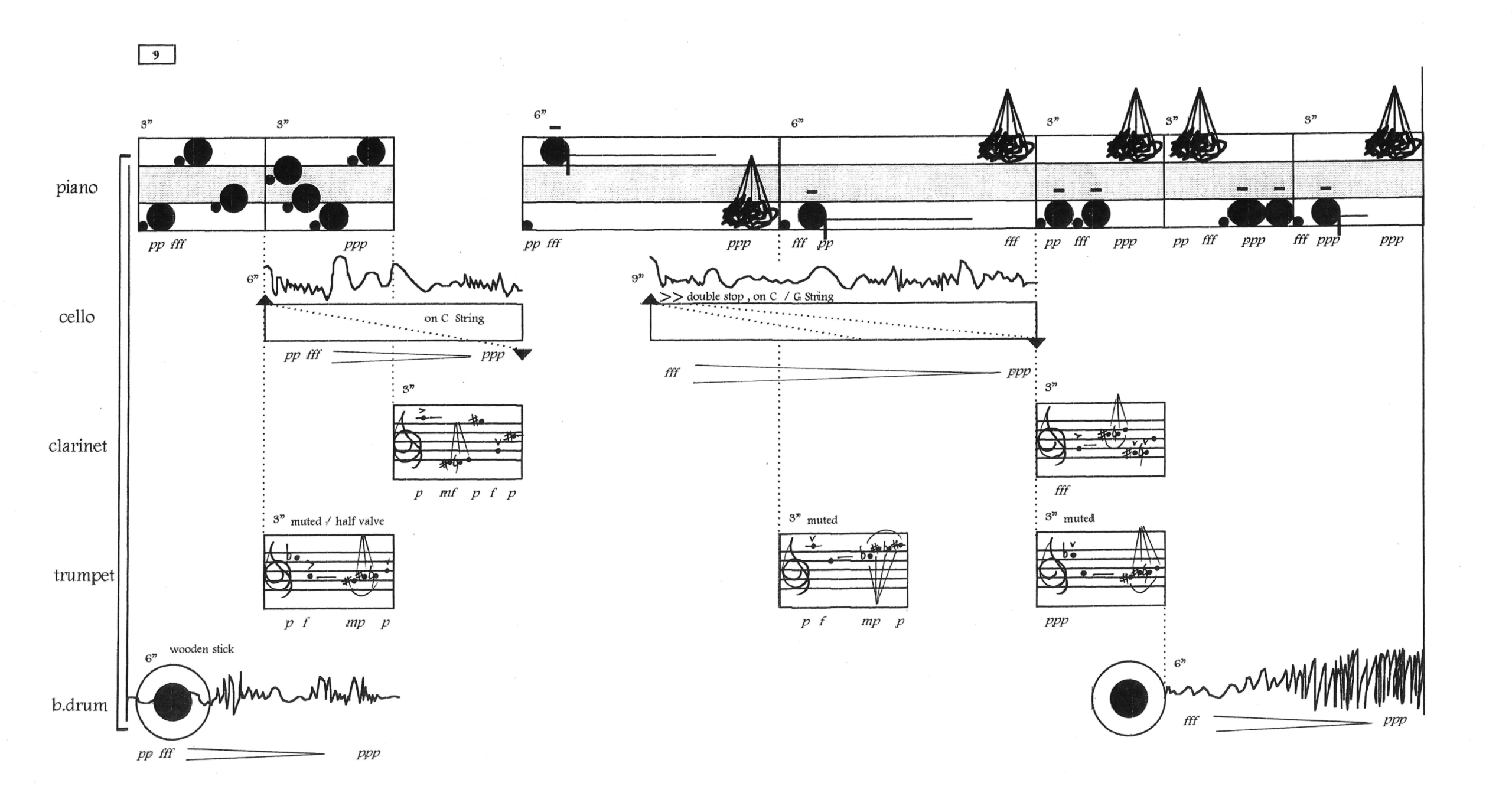
This composition contains definite instrumentation, whereas “Museik No. 10” did not. It also incorporates some elements of Western musical notation, including staves, clefs, and dynamics, as well as graphic elements such as squiggly lines, and abstract shapes. Scores that use a mixture of graphic and Western musical notations are sometimes called hybrid scores.
Time is also more determinate in “Conceptual View of Worlds I” than in “Museik No. 10.” Each instrument has a given horizontal space, and the work uses timeline notation, which was discussed more in Twentieth-Century Rhythmic Techniques. In this score musical events are divided into uneven groupings of seconds, which results in a feeling of ameter.
Listen to the recording of “Conceptual View of Worlds I” in Example 12 and follow along with the score in Example 11. Again, think about whether or not the performers interpreted the score in a way similarly to how you would have.[16]
Example 12 coming soon!
Example 12. “Conceptual View of Worlds I” performed by Scott Amman, Dr. Benjamin Corbin, Rebecca Gilmore Phillips, Dr. Kelly Rossum, and XXX (clarinet), recorded by Zach Gist.
Interpreting Graphic Scores with Instructions
Composers sometimes provide instructions or guidelines for their graphic scores. These instructions can be more or less detailed and might result in a more or less determinate performance. When interpreting scores with instructions, you should follow the directions or guidelines to the best of your ability. In the examples that follow, we will explore a few different graphic scores with directions.“Constellation” (2002) by Dimitris Maronidis (b. 1980) is written for four ottavini, three oboes, trumpet in D, harp, celesta, piano, bell, and three suspended plates.[17] The duration of the work is about five minutes. The composer’s explanation of and guidelines for the work are as follows:
“The conductor has also the role of the composer of this piece. [They define] the density, the intensity and also the spatial movement of the overall sound. Each musician improvises on a single free motif according to the conductor signals. The orchestra is the musical instrument and the conductor is in some way the performer. Many rehearsals may be required before the concert as for the orchestra and the conductor to establish a mutual and fast communication. All improvised phrases should return in an F#. At the end of the piece, a full range C major Chord sounds in a fff possible dynamic that slowly fades out. The duration of that last chord should be exactly 20”. When the sound dies out completely, the orchestra stays still for approximately 15”. The score is supposed to have a physical effect on musicians. The first section of the piece should resemble a crystalline sonic world with spectral development, while the second part (major chord) should sound as a solid sound mass denoting the end of the piece.”
Example 13 shows the graphic score for “Constellation,” while a recording can be heard in Example 14:
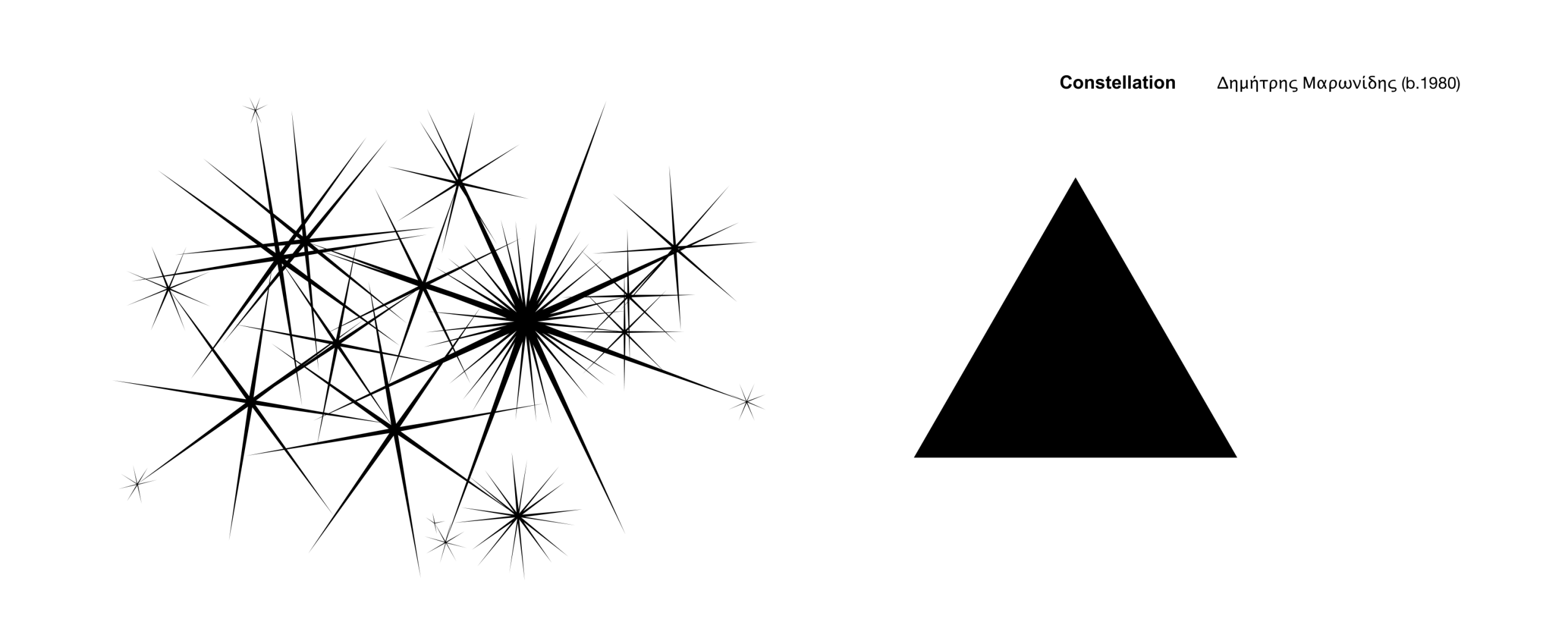
Example 14 coming soon!
Example 14. “Constellation” performed by ???.
Compare the recording in Example 14 with the score in Example 13. Do you think the performers successfully conveyed the graphic score? How well do you think they followed the composer’s guidelines? What would you change, if anything, about the performance?
Another example of a graphic score with directions is “Ballade” (2024) by Julien Monette (b. 2001), which is scored for piano and fixed media.[18]
The composer’s performance notes can be seen in Example 15:
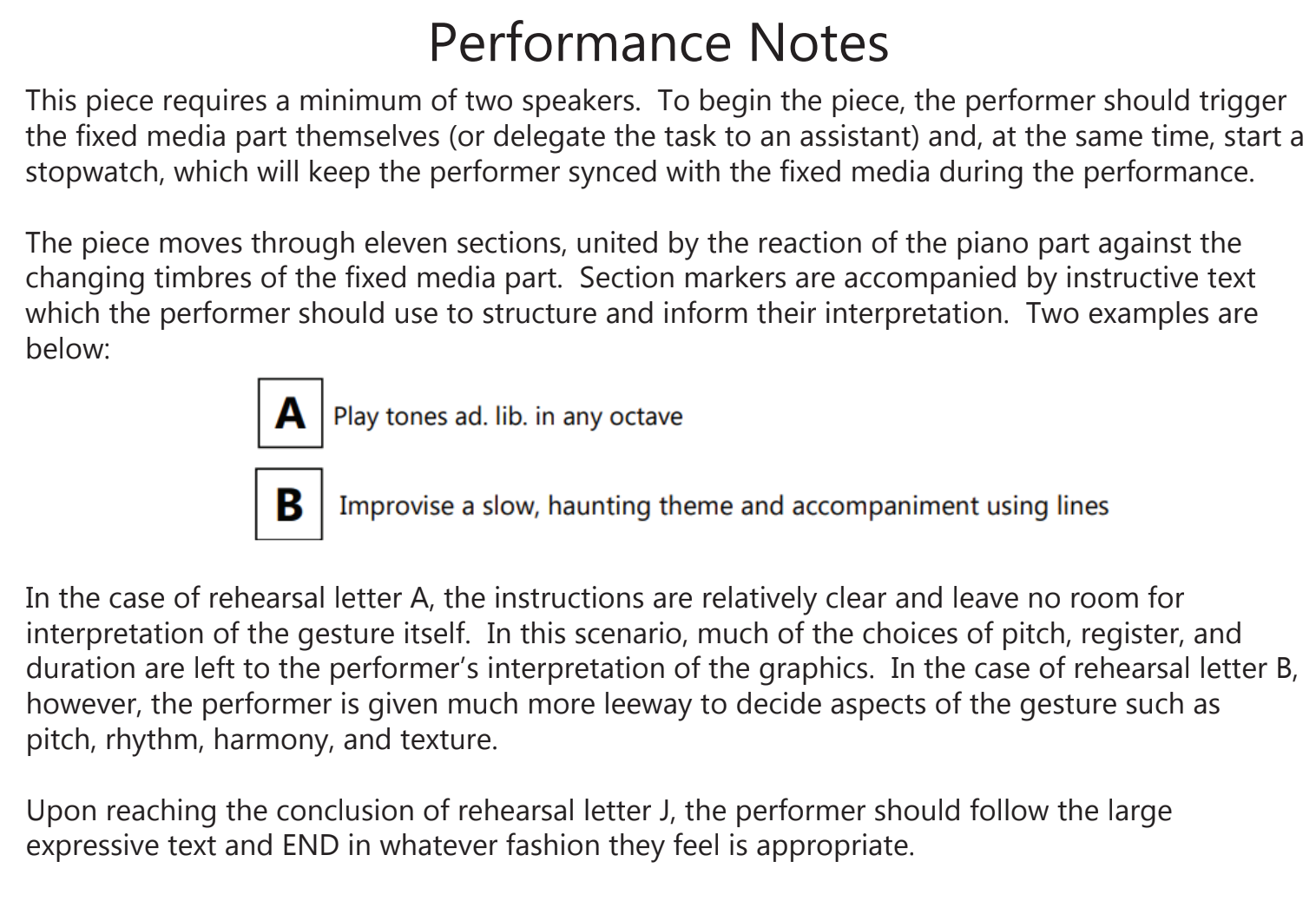
Example 16 shows an excerpt from page 6 of the graphic score for “Ballade”:
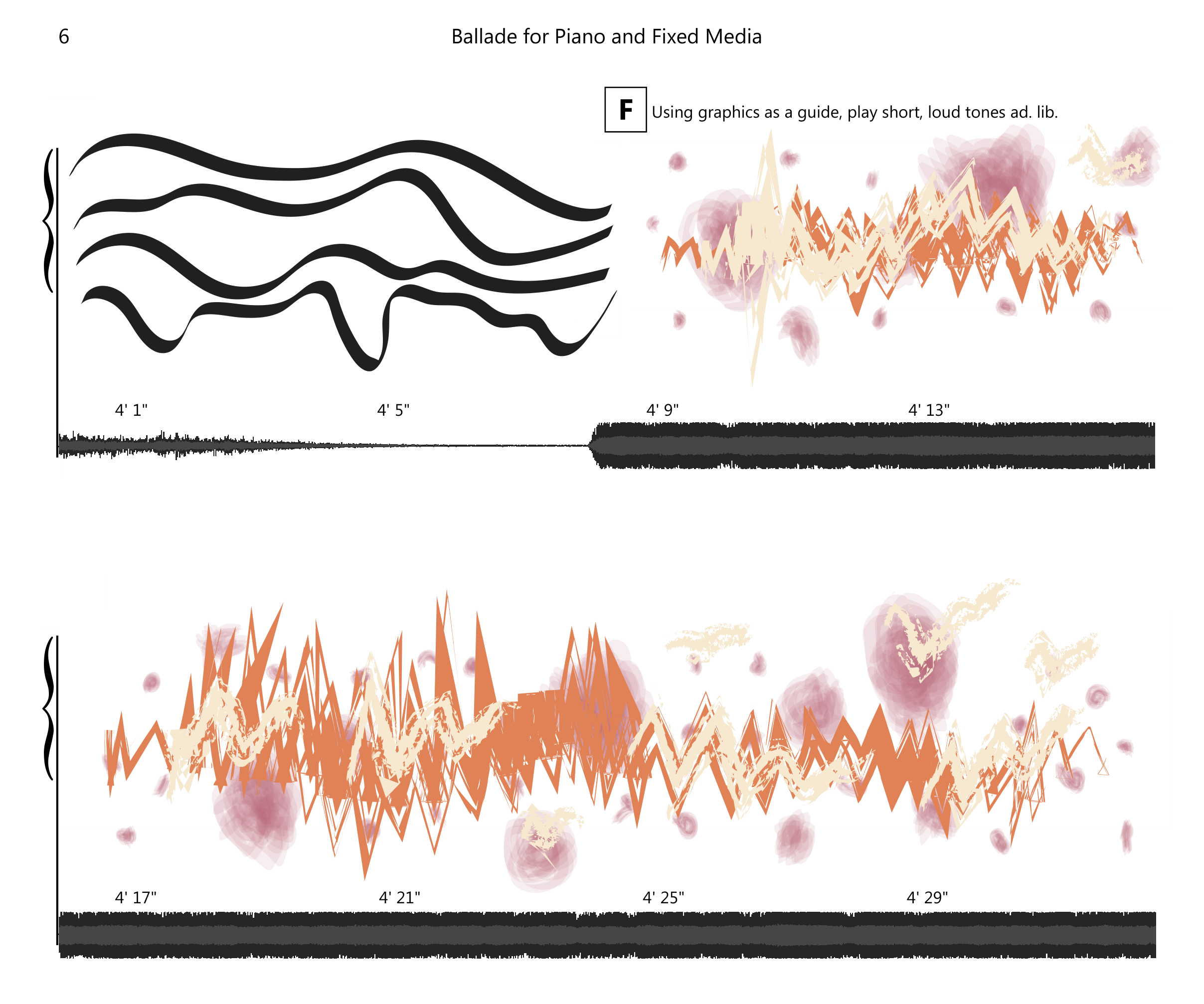
You may have noticed that Monette’s graphic score uses timeline notation, which was discussed more in Twentieth-Century Rhythmic Techniques. A recorded performance by the composer (fixed media) and Jonathan Martin (piano) can be heard in Example 17. Listen starting at 4:36 to hear the excerpt which is shown in Example 16 :
Example 17. A performance of “Ballade” by Julien Monette, performed by Julien Monette (fixed media) and Jonathan Martin (piano).
Again, compare the recording in Example 17 with the graphic score in Example 16 and ask yourself similar questions: do you think the performers successfully conveyed the graphic score? How well do you think they followed the composer’s guidelines? What would you change, if anything, about the performance?
Example 18 shows another example of a graphic score which is accompanied by composer instructions, “Jade Mountain Soundings” (1983) by Malcolm Goldstein (b. 1936), written for a solo bowed stringed instrument.[19]
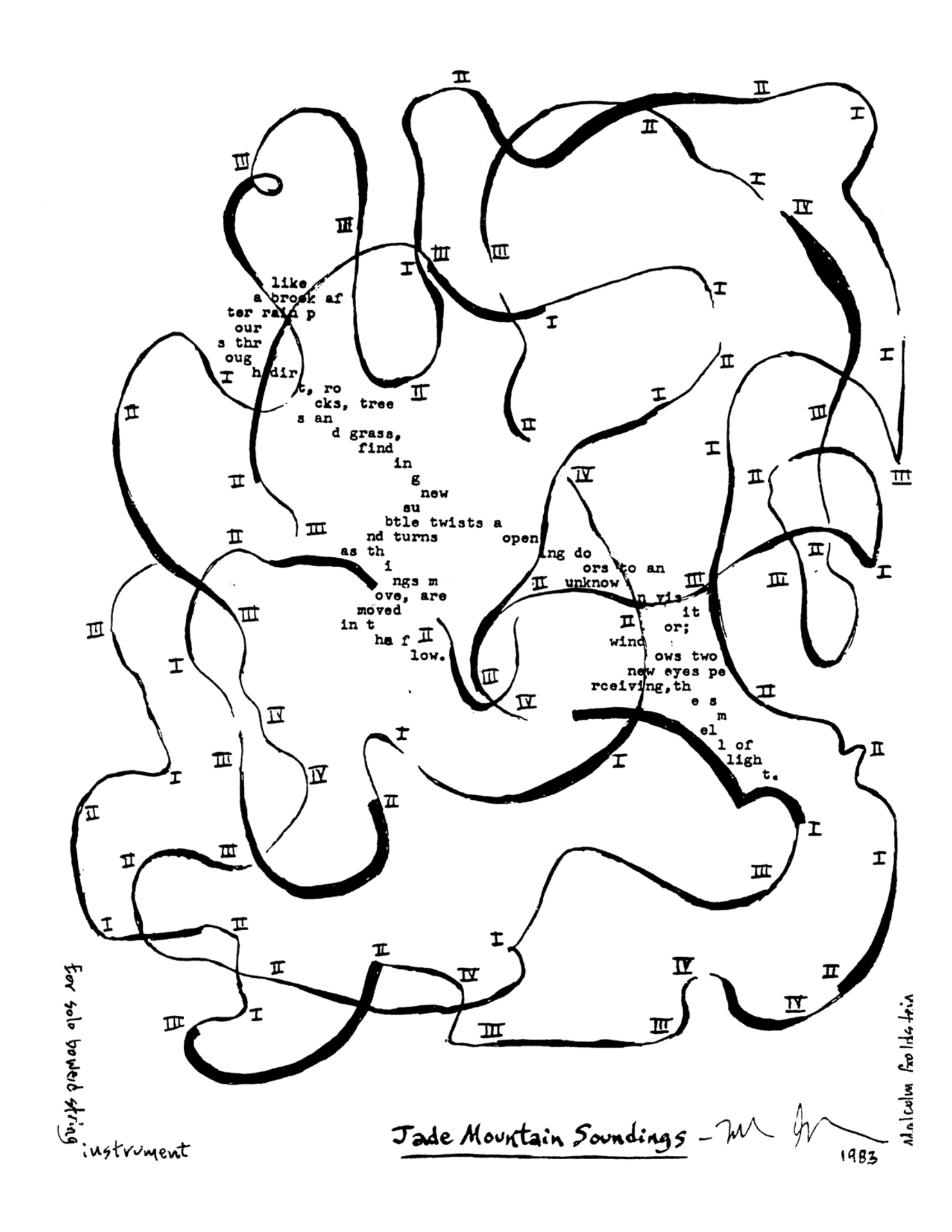
This work contains directions which are more detailed and longer than our previous examples. The composer’s directions can be read in Example 19:
![“The music focuses on aspects of sound-quality/texture expressed through the performance of a bowed string instrument: the physicality of generating the string to sound. Bow pressure, bow speed and bow placement are fundamental considerations in the sound of this music. The graphic score indicates, by thickness and curve of the line, changes in these aspects of performance technique. The lines, similarly conceived of as phrases, are always realized as sustained (legato, lyrical) bowings—as varieties of breathing (the bow upon/within the string). The music can also be conceived of as a kind of meditation.The instrumentalist determines four pitches, prior to the performance, which will be the total gamut of the piece. For example, the gamut can be as simple as [GACD] (i.e. for string bass), or as complicated as desired. Each pitch is fixed in its specific registration but, as indicated with the Roman numerals in the graphic score, can be played on any of the four strings–another possibility of expressing variety of sound-quality/texture for each pitch. (The Roman numerals indicate specific strings [I, II, III, IV] the highest to the lowest.) Harmonics (natural and artificial) are also possible, as long as the sounding pitch is within the same specific registration as the fingered pitch gamut. Each pitch is sustained until, following a line on the graphic score, another Roman numeral is arrived at–at which point the string player changes bow direction and plays another pitch (of the same pitch is possible if a different string is indicated). Bow direction changes, that occur at these points, should be as smooth as possible. Duration of the sustained pitch–always to be fit into one bow duration–is thus determined by the proportion of the length of line transverse from numeral to numeral. (As a guide 1 inch = 3 to 5 seconds, but this will depend on the string player’s bow control and facility.) Choice of pitch to be played is up to the choice of the performer; it is to be improvised. (It is possible to use one or two pitches for a while; also, it is possible to change pitch with every bow change–at the discretion of the performerNote that the apparent structure of the piece relates also to this process of time/spaces, of various rates of change, of pitch focus.) Dynamics, also, are improvised, from ppp to f, though never excessively loud. It will become apparent that, to a certain degree, the dynamics, as well as the articulation and decay of a pitch, will be controlled by the bow pressure/speed as indicated in the graphic score. (But dynamics and bow pressure are not synonymous.) A wide range of non-vibrato–varieties of vibrato should be used, with each pitch having its own quality. (It will happen that a heavy bow pressure and slow bow speed, without vibrato, will sound one way; whereas adding vibrato will radically alter the pitch/noise balance of the resulting sound. So, also, slight alterations of bow speed will alter the balance. In fact, any slight or gross alteration of any aspect of the total physical gesture–relationship of the string player through the bow to the string–will be expressed in the sound being generated. This should be explored in the process of preparing the music for performance. The lines of the graphic score should be thought of as phrases that are expressed as much by varieties of bow pressure, bow speed, and bow placement, as by pitch and dynamic changes. The thickness of the line indicates the amount of bow pressure and/or bow speed: thick = more pressure and/or less speed; thin = less pressure and/or more speed. (However, the bow speed, at times, can be interpreted the reverse of the above, since it will also be conditioned by the duration of the sustained pitch.) The notations also indicate manners of articulating and performing these bowing techniques: sudden changes of pressure, (symbol); gradual changes, (symbol); a constant, sustained condition by constant thickness; gradual changes and/or irregular changes by analogous indications in the graphic line, to be expressed literally in the performance technique. (Heavy bow pressure indicated by the thickest line, should be almost at the edge of noise–but always with pitch clearly perceptible.) The curvature of the line indicates changes of bow placement: from on the bridge to on the fingerboard and anywhere in between. When the line curves more gradually, so also the shift of bow placement is more subtle; when the line curves more suddenly or extremely, so also the bow placement should change accordingly (but always legato). In what direction these changes take place is up to the choice of the performer. (Other possible interpretations of line curvature include use of bow wood to varying degrees and variety of vibrato–but these are secondary to bow placement.) Some phrases (lines) are quite long and might last several minutes. Some sustained pitches might last a very long bow length; possibly 30 seconds. The instrumentalist will have to practice so as to be able to experience and thus express these lines as phrases, that is to say, related to the physicality of breathing, rather than as abstract durations. Silences, at the ending and beginning of phrases, are indicated by breaks in the continuity of the line(s). (Occasionally a phrase can be ended with a plucked note.) The performer starts at the beginning of any line and follows it in any direction. (In the course of the performance, the same line might be read in the opposite direction.) Lines that are crossed can, as well, sometimes be shifted to, so as to create a new phrase. (At points like this, as well as at any times when pitch/string notation is ambiguous or unclear, the performer can choose which string and/or pitch to play.) The performance path is always one of the following a line to its end and the proceeding, after the appropriate silence indicated by empty space, to the next line that is suggested by the linear continuity. In the course of the performance, lines may be repeated. However, always allow for unique sound-quality/textures to occur, rather than attempting to repeat exactly or attempting to create patterns of material. The music lasts as long as desired by the performer, but no less than 10 minutes duration. (More probably, the music will evolve over a long span of time.) Malcolm Goldstein July 4, 1983 Sheffield, Vermont](https://viva.pressbooks.pub/app/uploads/sites/12/2025/07/Jade-Mountain-Soundings-Directions-Malcolm-Goldstein-e1752603702637.png)
A recording of “Jade Mountain Soundings” by the ensemble Extradition (as part of their Extradition Plays Goldstein concert series) can be heard in Example 20:
Example 20. A performance of “Jade Mountain Soundings” by Malcolm Goldstein, performed by the ensemble Extradition.
As you listen to the recording Example 20 and compare it with the graphic score in Example 18 (and the directions in Example 19), you may ask yourself similar questions to those which we’ve already asked: do you think the performers successfully conveyed the graphic score? How well do you think they followed the composer’s guidelines? What would you change, if anything, about the performance?
Measuring Time and Hybrid Scores
In this chapter we have mentioned several graphic scores in which time is measured with timeline notation. Timeline notation measures time with seconds rather than with bar lines and time signatures. Seconds in timeline notation can be measured in one of two ways: evenly, or unevenly. “Ballade” by Julien Monette (Example 16) shows an even division of seconds (every four seconds is notated in a grid-like fashion), while “Conceptual View of Worlds I” by Kyong Mee Choi (Example 11) is an example of a graphic score in which seconds are notated unevenly (i.e. seconds appear in groups of 3 or 6).
However, a composer may also provide no indication of time progression within their score. When this is the case, we say the music is in free time. “Museik No. 10” by Henrik Colding-Jørgensen (Example 9) is an example of a graphic score in free time.
We have also mentioned hybrid scores, which contain elements of both graphic scores and traditional Western musical notation. We have already seen several examples of hybrid scores in this chapter, including “Belle, Bonne, Sage,” by Baude Cordier (Example 2), “Selfie” by John Dante Prevedini (Example 4), “Fabric” by Henry Cowell (Example 6), and “Conceptual View of Worlds I” by Kyong Mee Choi (Example 11). Based upon these different examples, you can see that some hybrid scores contain more staff notation, some contain more graphic notation, and some contain about an equal amount of both.
We will close the chapter with an excerpt from “Unstable Revolutions” (2019) by Maxwell Tfirn (b. 1987), seen in Example 21, which is another example of a hybrid score:

A recording of “Unstable Revolutions” can be found in Example 22:, performed by the Fifth Bridge Electro-acoustic Trumpet Ensemble:
Example 22. A performance of “Unstable Revolutions” by Maxwell Tfirn, performed by the Fifth Bridge Electro-acoustic Trumpet Ensemble, with a visualization by Maxwell Tfirn.
Listen to the excerpt in Example 21, which starts at 3:15 in Example 22. Note that “Unstable Revolutions” uses timeline notation, but the time points do not form an even metric grid (e.g. 3’24” to 3’29” is five seconds while 3’29” to 3’37” is eight seconds). You can also see the hybrid nature of the score: there are elements of traditional Western musical notation, such as staves, clefs, and note heads, but there are also graphic elements, such as the lines at the bottom of the systems which represent the computer part.
- Bent, Ian et. al. 2001, “Notation.” Grove Music Online. https://doi.org/10.1093/gmo/9781561592630.article.20114.
- Behrman, David. 1965. “What Indeterminate Notation Determines.” Perspectives of New Music 3, no. 2: 58–73.
- Cowell, Henry. 1930. New Musical Resources. New York: Alfred A. Knopf.
- Dart, Thurston. 2001. “Eye Music.” Grove Music Online. https://doi.org/10.1093/gmo/9781561592630.article.09152.
- Gutkin, David. 2012. “Drastic or Plastic?: Threads from Karlheinz Stockhausen’s Musik und Graphik, 1959.” Perspectives of New Music 50, nos. 1/2: 255–305.
- Inglis, Brian. 2015. “Towards an analytical framework for graphic scores, and a proposed typology.” Putting the Graphic in Music: Notation, Analysis, and Performance. London: Senate House Library, link.
- Hitchcock, H. Wiley, revised by Christopher Hopkins. “Notation in the United States.” Grove Music Online. https://doi.org/10.1093/omo/9781561592630.013.90000330322.
- Karkoschka, Erhard, trans. Ruth Koenig. 1972 trans. Notation in New Music. New York: Praeger Publishers.
- Kohs, Juraj. 2011. “Beyond Notation: Communicating Music.” Leonardo Music Journal 21: 65–72.
- Kontarsky, Aloys and Vernon Martin. 1972. “Notation for Piano.” Perspectives of New Music 10, no. 2: 72–91.
- Lewis, Kevin D. 2010. “A Historical and Analytical Examination of Graphic Systems of Notation in Twentieth-Century Music.” MM Thesis, University of Akron.
- Manning, Peter et. al. 2001. “Computers and Music.” Grove Music Online. https://doi.org/10.1093/gmo/9781561592630.article.40583.
- Pritchett, James, Laura Kuhn, and Charles Hiroshi Garrett. 2013. “Cage, John (Milton, Jr.).” Grove Music Online. https://doi.org/10.1093/gmo/9781561592630.article.A2223954. ↵
- Read, Gardner. 1998. Pictographic Score Notation. Westport, CT: Greenwood Press.
- Sauer, Theresa ed. 2009. Notations 21. New York: Mark Batty Publisher.
- Smith, Sylvia, and Stuart Smith. 1981–1982. “Visual Music.” Perspectives of New Music 20, nos. 1/2: 75–93.
- Vigil, Ryan. 2009. “Compositional Parameters: ‘Projection 4’ and an Analytical Methodology for Morton Feldman’s Graphic Works.” Perspectives of New Music 47, no. 1: 233–67.
- Weisser, Benedict J. 1998. “Notational Practice in Contemporary Music: A Critique of Three Compositional Models (Luciano Berio, John Cage, and Brian Ferneyhough).” Ph.D. Diss, the City University of New York.
- Graphic Notation: a Brief History of Visualizing Music (DOC Magazine)
- Graphic Scores (for children) (Birmingham Contemporary Music Group)
- The Joy and the Challenge of Graphic Scores (Scanner, the website of composer Robin Rimbaud)
- Making a Graphic Score (samxumusic, music education resource website by Sam Xu)
- What are Graphic Scores? (School of Noise)
- Alarm Will Sound (ensemble)
- Extradition (ensemble)
- Fifth Bridge Electro-acoustic Trumpet Ensemble (ensemble)
- John Cage Trust
- Kyong Mee Choi
- Henrik Colding-Jørgensen
- Rajmil Fischman
- Malcolm Goldstein
- Barbara Heller
- Mara Helmuth
- Christoph Herndler
- Panayiotis Kokoras
- John Kannenberg
- John Lane
- Martin Loyato
- Dimitris Maronidis
- Julien Monette
- John Dante Prevedini
- Maxwell Tfirn
- Composing Graphic Scores (.pdf, .docx). Asks students to compose a graphic score and to provide directions and an explanation.
- Analyzing Graphic Scores without Instructions (black and white) (.pdf, .docx). Asks students to look at a graphic score with no instructions and to answer questions about it.
- Analyzing Graphic Scores without Instructions (color) (.pdf, .docx). Asks students to look at a graphic score with no instructions and to answer questions about it.
Media Attributions
- Museik No. 10 Henrik Colding-Jorgensen © Henrik Colding-Jørgensen is licensed under a CC BY-SA (Attribution ShareAlike) license
- Belle Bonne Sage Baude Cordier © Wikimedia Commons is licensed under a Public Domain license
- Selfie John Dante Prevedini © John Dante Prevedini is licensed under a CC BY-SA (Attribution ShareAlike) license
- Fabric Henry Cowell © IMSLP is licensed under a Public Domain license
- Conceptual View of Worlds I Page 9 Kyong Mee Choi © Kyong Mee Choi is licensed under a All Rights Reserved license
- Constellation Dimitris Maronidis © Dimitris Maronidis is licensed under a CC BY-SA (Attribution ShareAlike) license
- Ballade Julien Monette Directions © Julien Monette is licensed under a All Rights Reserved license
- Ballade Page 6 Julien Monette © Julien Monette is licensed under a All Rights Reserved license
- Jade Mountain Soundings Malcolm Goldstein © Malcolm Goldstein is licensed under a All Rights Reserved license
- Jade Mountain Soundings Directions Malcolm Goldstein © Malcolm Goldstein is licensed under a All Rights Reserved license
- Unstable Revolutions Maxwell Tfirn © Maxwell Tfirn is licensed under a All Rights Reserved license
- Used with permission of the composer. The composition is free for anybody to copy or perform, on the condition that performances and visual copies are free for anybody. ↵
- Malcolm Goldstein (composer), interview by Zach Gist, June 25, 2025. ↵
- Thurston Dart, "Eye music," Grove Music Online, https://doi.org/10.1093/gmo/9781561592630.article.09152. ↵
- Used with permission of the composer. ↵
- John Dante Prevedini, "How Audiences See the World," in Classical Music Daily, December 2020, https://www.classicalmusicdaily.com/2020/12/socialmedia.htm. ↵
- Kevin D. Lewis, “A Historical and Analytical Examination of Graphic Systems of Notation in Twentieth-Century Music” MM Thesis, (University of Akron, 2010). ↵
- Henry Cowell, New Musical Resources (New York: Alfred A. Knopf, 1930). Of Western rhythmic notation, Cowell wrote: "Certain limitations at once suggest themselves," (49). ↵
- Ibid., 56. ↵
- Lewis, "A Historical and Analytical Examination," 20. ↵
- Morton Feldman, Projection 1 (C.F. Peters, composed 1950, published 1961), 1. ↵
- James Pritchett, Laura Kuhn, and Charles Hiroshi Garrett, "Cage, John (Milton, Jr.)" Grove Music Online, https://doi.org/10.1093/gmo/9781561592630.article.A2223954. ↵
- Pritchett, et. al, "Cage, John," Grove Music Online. ↵
- Used with permission of the composer. The composition is free for anybody to copy or perform, on the condition that performances and visual copies are free for anybody. ↵
- About “Museik No. 10,” composer Henrik Colding-Jørgensen has said: “There are no predefined “right” ways to perform or rehearse this music or to interpret the graphics. You have to find your own ways to sort out ideas and inspirations, and with an ensemble you also have to establish a trusting and confident cooperation.” From Notations 21 edited by Theresa Sauer, (New York: Mark Batty Publisher), 54. ↵
- Used with permission of the composer. ↵
- Composer Kyong Mee Choi has spoken to the unique creativity she affords her schoores. “I have found that adding a graphic dimension to by scores gives me room to be creative and to put a personal stamp on my music. It is great to invent something unique of one’s own. Because each piece, after all, is one-of-a-kind.” Notations 21, 53. ↵
- Used with permission of the composer. ↵
- Used with permission of the composer. ↵
- Used with permission of the composer. ↵
A notational technique that uses images, shapes, colors, and/or various other symbolic features to represent music instead of traditional staff notation.
German for “eye music;” a type of music notation which alters the design and layout of traditional musical features to display a shape, design, or picture.
A picture or symbol which represents an idea or concept.
A philosophical approach and compositional technique in music that leaves elements within the music undetermined. These elements can be left up to the discretion of the performer or to chance.
When the compositional process and/or performance of a work are determined by random procedures. Examples could include dice rolls or coin tosses.
A philosophical view that states that the judgement of beauty is relative to an individual or to a culture; a stance that believes that there is no universal criteria of beauty.
A score that contains prominent elements from both traditional and graphic notation.
A contemporary metric technique that uses seconds as the measure of time, rather than traditional bar lines and meters.
A type of musical score that uses images, shapes, colors, and/or various other symbolic features to represent music instead of traditional staff notation.
Music that does not have any perceivable meter.
To remain silent (to not play or sing) during a performance.
Free time refers to music with no discernible beat or time signature. Music in free time often has very little (or no) rhythmic structure.

